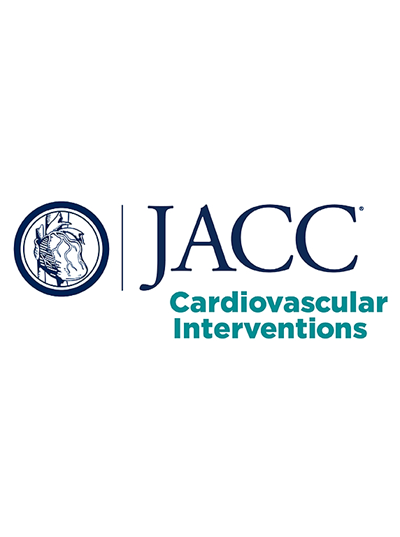Biphasic Right Ventricular Reverse Remodeling Following Tricuspid Valve Transcatheter Edge-to-Edge Repair
IF 11.7
1区 医学
Q1 CARDIAC & CARDIOVASCULAR SYSTEMS
引用次数: 0
Abstract
Background
Transcatheter tricuspid valve edge-to-edge repair (T-TEER) has been reported to be associated with right ventricular reverse remodeling (RVRR). Data on the temporal evolution of this phenomenon are scarce.
Objectives
The aim of this study was to evaluate RVRR over the course of 2-year follow-up after T-TEER using sequential 3-dimensional echocardiograms (3DE).
Methods
The study included T-TEER patients with available 3DE at baseline and discharge. Further follow-ups were scheduled at 1 month, 6 months, as well as 1 and 2 years. The 3DE evaluation included right ventricular volumes (right ventricular end-diastolic volume [RVEDV3D]; right ventricular end-systolic volume [RVESV3D]), right ventricular ejection fraction (RVEF3D), and RV longitudinal strain of the free wall and the septum.
Results
The study included 231 patients (median age 82 [IQR: 79-86] years, 48% women). We observed a biphasic pattern of RVRR following T-TEER consisting of early RV volume unloading (phase 1, reduced RVEDV3D) and later structural remodeling (phase 2, reduced RVESV3D). Whereas RVEDV3D was significantly reduced early after the procedure (−9.7% from baseline to discharge; P < 0.001), RVESV3D remained unchanged at 1-month follow-up. Reduction in RVESV3D was observed at 6-month follow-up for the first time (−5.4% from baseline to 6-month follow-up; P < 0.001). Reduction in both RVEDV3D and RVESV3D peaked at 1-year follow-up and remained stable until 2 years after T-TEER. RV function declined early after T-TEER and gradually increased over the course of follow-up (RVEF3D at baseline 42.2% ± 8.9%, discharge 31.1% ± 9.4%, 2-year follow-up 41.6% ± 8.9%). The 3D RV longitudinal strain of the septum and 3D RV longitudinal strain of the free wall developed analogously.
Conclusions
RVRR following T-TEER occurs in 2 stages and involves early RV unloading (reduction in RVEDV3D) and later structural RVRR (reduction in RVESV3D) with an improvement in RVEF.
经导管三尖瓣边缘修复后双相右心室反向重构。
背景:经导管三尖瓣边缘到边缘修复(T-TEER)已被报道与右心室反向重构(RVRR)相关。关于这一现象的时间演变的数据很少。目的:本研究的目的是利用序贯三维超声心动图(3DE)评估T-TEER术后2年随访期间的RVRR。方法:研究纳入基线和出院时可获得3DE的T-TEER患者。随访时间分别为1个月、6个月、1年和2年。3DE评估包括右心室容积(右心室舒张末期容积[RVEDV3D];右心室收缩末容积[RVESV3D])、右心室射血分数(RVEF3D)、右心室游离壁和间隔纵向应变。结果:研究纳入231例患者(中位年龄82岁[IQR: 79-86]岁,女性48%)。我们观察到T-TEER后RVRR呈双相模式,包括早期RV体积卸载(第1期,RVEDV3D减少)和后期结构重构(第2期,RVESV3D减少)。然而RVEDV3D在手术后早期显著降低(从基线到出院-9.7%;P < 0.001), RVESV3D在1个月随访时保持不变。在6个月的随访中首次观察到RVESV3D下降(从基线到6个月随访-5.4%;P < 0.001)。RVEDV3D和RVESV3D的减少在随访1年达到顶峰,并保持稳定,直到T-TEER后2年。T-TEER术后右心室功能早期下降,随随访逐渐升高(RVEF3D基线42.2%±8.9%,出院31.1%±9.4%,2年随访41.6%±8.9%)。隔膜的三维RV纵向应变与自由壁的三维RV纵向应变相似。结论:T-TEER后RVRR分2期发生,包括早期RV卸荷(RVEDV3D减少)和晚期结构性RVRR (RVESV3D减少),RVEF改善。
本文章由计算机程序翻译,如有差异,请以英文原文为准。
求助全文
约1分钟内获得全文
求助全文
来源期刊

JACC. Cardiovascular interventions
CARDIAC & CARDIOVASCULAR SYSTEMS-
CiteScore
11.60
自引率
8.80%
发文量
756
审稿时长
4-8 weeks
期刊介绍:
JACC: Cardiovascular Interventions is a specialist journal launched by the Journal of the American College of Cardiology (JACC). It covers the entire field of interventional cardiovascular medicine, including cardiac, peripheral, and cerebrovascular interventions. The journal publishes studies that will impact the practice of interventional cardiovascular medicine, including clinical trials, experimental studies, and in-depth discussions by respected experts. To enhance visual understanding, the journal is published both in print and electronically, utilizing the latest technologies.
 求助内容:
求助内容: 应助结果提醒方式:
应助结果提醒方式:


